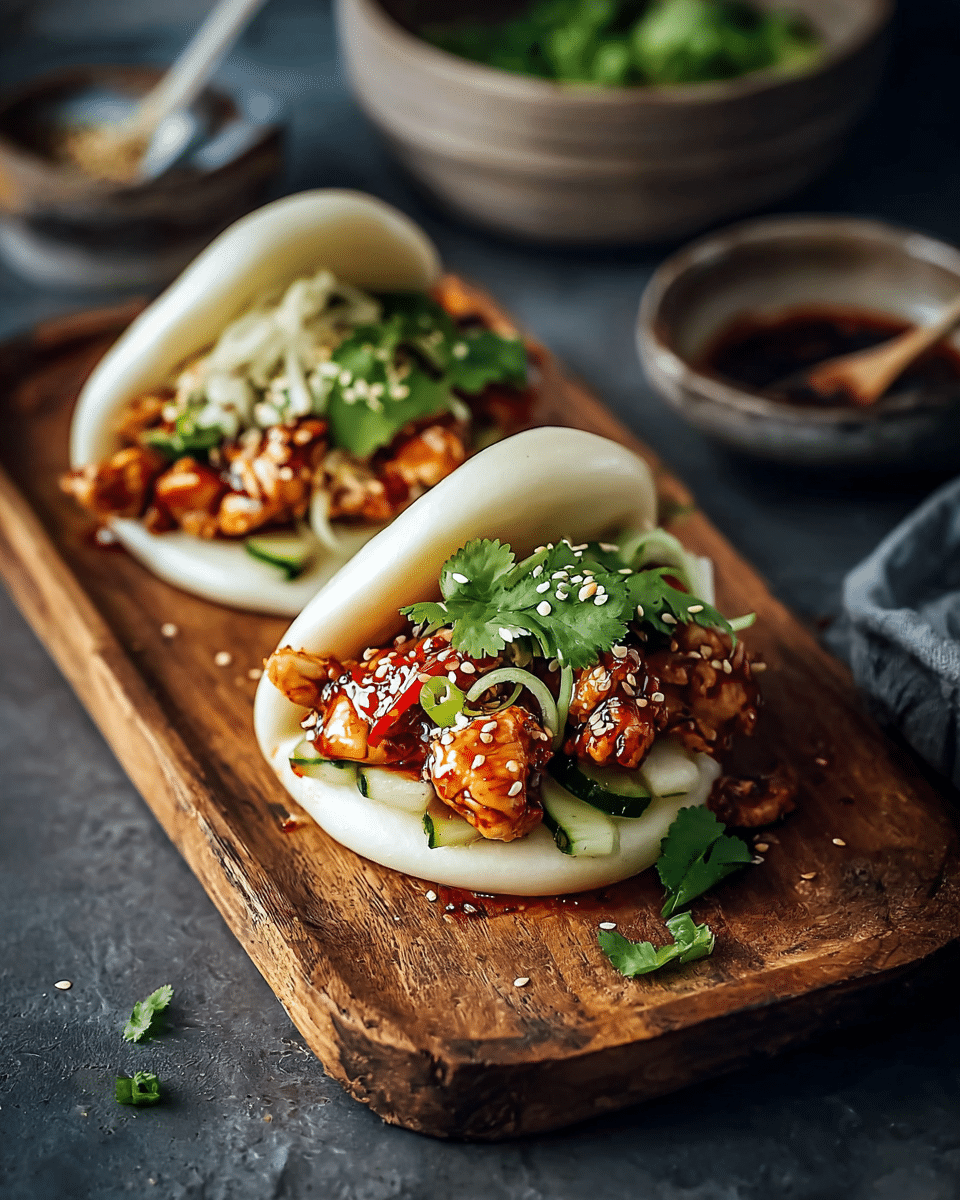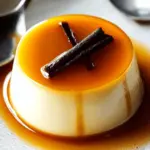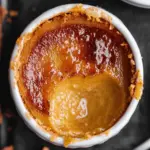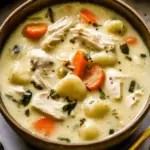Korean Chicken Bao is a dish that beautifully merges two culinary traditions into one irresistible bite. It takes inspiration from the soft, pillowy bao buns of Chinese cuisine and pairs them with the bold, addictive flavors of Korean fried chicken. The result is a handheld delight that offers a contrast of textures and flavors—fluffy steamed buns, crunchy chicken, sticky-sweet glaze, crisp pickled vegetables, and a drizzle of creamy sauce to tie it all together. Each component contributes to a multi-layered experience that is at once comforting, exciting, and visually appealing. Over the last few years, this recipe has grown into a street food favorite worldwide, often seen in trendy food markets, Asian fusion restaurants, and home kitchens looking to recreate the experience. What makes Korean Chicken Bao so loved is not only the flavor but also the versatility—it works just as well as a party appetizer as it does for a weeknight dinner, appealing to both adventurous eaters and comfort food lovers alike.
Full Recipe:
Ingredients
-
Steamed bao buns (store-bought or homemade)
-
Boneless chicken thighs or breasts
-
Cornstarch (for coating)
-
Oil for frying
-
Gochujang (Korean chili paste)
-
Soy sauce
-
Honey or brown sugar
-
Rice vinegar
-
Garlic, minced
-
Ginger, minced
-
Mayonnaise (optional, for topping)
-
Pickled cucumbers or radishes
-
Fresh cilantro or scallions
Directions
-
Coat chicken pieces lightly with cornstarch and fry until golden and crispy.
-
In a pan, prepare the sauce by mixing gochujang, soy sauce, honey, vinegar, garlic, and ginger. Cook until it thickens into a glaze.
-
Toss fried chicken in the sauce until well coated.
-
Warm bao buns until soft and fluffy.
-
Fill each bao with sauced chicken, pickled vegetables, and herbs.
-
Add a drizzle of mayonnaise or extra sauce before serving.
Nutrients
-
Calories: ~320 kcal per bao
-
Protein: 18 g
-
Carbohydrates: 35 g
-
Fat: 12 g
-
Fiber: 2 g
-
Sugar: 8 g
Why This Recipe Stands Out
Korean Chicken Bao is not your average sandwich or snack—it stands out because of its balance of cultures and flavors. The crisp, golden chicken coated in a sticky, spicy-sweet glaze delivers all the addictive qualities of Korean fried chicken. Pairing it with bao buns, which are light and fluffy like little edible pillows, turns it into a portable comfort food masterpiece. Each bite hits multiple flavor notes: spicy heat from gochujang, savory umami from soy, sweetness from honey, tang from vinegar, and freshness from herbs and pickled vegetables. Unlike many other recipes, this dish can be customized easily—those who prefer bold spice can increase the chili paste, while those who like a sweeter balance can add extra honey. The combination of texture, flavor, and visual appeal makes it ideal for gatherings where food should both taste delicious and look impressive.
The Benefits of the Ingredients
Every ingredient in Korean Chicken Bao plays a role beyond flavor. The chicken serves as a lean protein source, keeping the dish filling and satisfying. Gochujang, the key to its signature flavor, is a fermented paste that brings probiotics along with its spicy-umami depth. Garlic and ginger do more than just enhance taste—they contribute antioxidants and compounds known for supporting immune health. The pickled cucumbers or radishes add crunch and probiotics that help with digestion, while cilantro and scallions provide freshness and essential vitamins. The bao buns, though indulgent, are not overly heavy, making them a suitable vehicle for the chicken and toppings. Together, these ingredients create harmony not only in flavor but also in nutrition, giving diners a balance of protein, carbs, and beneficial plant-based additions in each serving.
Cooking Tips
Achieving the perfect Korean Chicken Bao comes down to careful preparation of both the chicken and the bao. The chicken’s crispiness is key, so maintaining the right oil temperature is essential. If the oil is too cool, the chicken will absorb excess oil and turn greasy; too hot, and the outside may burn before the inside is fully cooked. Many Korean cooks recommend double-frying chicken to lock in extra crunch that holds up even when coated in sauce. For the sauce, simmering it just enough to thicken ensures it clings to each piece without dripping excessively. Adjust the spice and sweetness based on personal preference by playing with the ratio of gochujang, honey, and soy. Bao buns are best served fresh and warm; steaming them right before assembling keeps them soft and fluffy. To avoid overpowering the balance, resist the temptation to overfill the buns—just enough chicken, vegetables, and herbs create the ideal handheld bite.
Serving Suggestions
The versatility of Korean Chicken Bao makes it a great fit for many dining occasions. As a main meal, they can be served with sides like kimchi, Asian slaw, or crispy sweet potato fries for a complete plate. For a lighter touch, pair them with cucumber salad or pickled daikon radish, which cuts through the richness. At gatherings, these buns shine as shareable finger food—arrange them on a platter with small bowls of toppings such as sesame seeds, extra sauce, or spicy mayo for a fun, interactive element. For drinks, beer pairs perfectly, especially lighter lagers or citrusy IPAs, but non-alcoholic options like sparkling water with lime or chilled green tea balance the strong flavors just as well. Whether for weeknight dinners, backyard barbecues, or casual parties, Korean Chicken Bao adapts beautifully to the setting, always delivering a memorable experience.
Conclusion
Korean Chicken Bao is more than just food—it is an experience that bridges cultures and celebrates flavor. Its appeal lies in the perfect balance of crispy chicken coated in a spicy-sweet glaze nestled inside a soft, cloud-like bao bun. The dish is indulgent without being heavy, striking the right balance of comfort and excitement. Beyond taste, it also symbolizes the creative possibilities that arise when culinary traditions blend together. Making Korean Chicken Bao at home is both rewarding and fun, offering a chance to share not just a meal but also an atmosphere of joy and connection around the table. Every bite tells a story of texture, flavor, and creativity, making it a recipe that deserves a spot in any food lover’s collection. From family dinners to festive gatherings, this dish brings bold flavors, satisfying textures, and a sense of celebration to every occasion.






